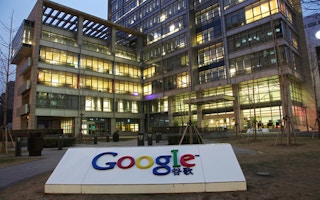Apple Inc, Google Inc and Facebook Inc have made significant progress in adopting renewable energy sources to power their Web services, the environmental group Greenpeace said in a report on Wednesday.
But energy-hungry data centres operated by some of the Internet industry’s top companies remain overly reliant on carbon-emitting coal and gas, the report said.
Apple Inc, which built an on-site solar panel farm and fuel-cells at its North Carolina data centre and has procured renewable energy directly at its other three facilities, earned the highest marks on the “scorecard” of Internet company data centers that Greenpeace issues every two years.
Greenpeace rated Apple’s efforts in transparency, renewable energy policy and renewable energy deployment with an A grade in each category, compared with a mix of D and F grades two years ago when the group released its last report.
“
A large Internet data centre requires energy capacity of as much as 80 megwatts, which would be enough to power about 65,000 US homes
David Pomerantz, Greenpeace spokesman
At the other end of the spectrum, Amazon.com Inc’s Web Services business, which Greenpeace said operates at least 18 data centres around the world, was singled out for being among the least committed to renewable energy, earning F grades in three out of Greenpeace’s four categories.
Some Internet companies “have refused to pay even lip service to sustainability and are simply buying dirty energy straight from the grid,” said the report. “Those companies, most notably Amazon Web Services, are choosing how to power their infrastructure based solely on lowest electricity prices.”
Amazon disputed Greenpeace’s assessment of its data centre operation, saying that the report’s data and assumptions were inaccurate. Amazon said in an emailed statement that data centres in two regions in which it operates use “100 per cent carbon-free power” without elaborating.
Data centres, multibillion-dollar facilities stuffed with racks of tightly-packed computers, are the heart of the fast-growing Internet industry. The facilities store consumers’ email and other personal data, and help deliver popular online offerings such as Netflix’s streaming video service and Facebook’s photo-laden social network.
A large Internet data centre requires energy capacity of as much as 80 megwatts, which would be enough to power about 65,000 US homes, according to Greenpeace spokesman David Pomerantz.
The increasing prevalence of Internet services means growing demand for electricity in the coming years, Greenpeace said.
Six major Internet services companies - Facebook, Apple, Google, Box, Rackspace and Salesforce.com - have committed to making their data centre operations 100 per cent based on renewable energy, according to the report. Those commitments are putting pressure on utilities to offer wind, solar and other forms of renewable power, Greenpeace said.
The report looked at 19 companies that operate more than 300 data centres combined. Greenpeace used information provided by the companies and utilities to estimate what portion of a company’s Internet infrastructure is going to be based on renewable energy, which it refers to as a “Clean Energy Index.”
Renewable energy credits, which a company can purchase to meet clean energy goals, were not counted.
Apple’s Clean Energy Index was 100 percent, while Facebook and Google were rated by Greenpeace at 49 percent and 48 percent, respectively.
Google has been a leader in committing to renewable energy, with procurement deals to purchase wind power from utilities in several states, Greenpeace said. But with 13 data centres, compared with Apple’s four, the company faces a bigger task in shifting its overall energy usage to renewable sources.
Amazon Web Services, which Greenpeace said operates more than 10 data centers in the Virginia area, had a Clean Energy Index of 15 per cent, according to Greenpeace.










